
Catsharks are ground sharks of the family Scyliorhinidae. They are one of the largest families of sharks with around 160 species placed in 17 genera. Although they are generally known as catsharks, many species are commonly called dogfish or gato. Like most bottom feeders, they feed on benthic invertebrates and smaller fish. Catsharks are not harmful to humans.
Asymbolus is a genus of catsharks in the family Scyliorhinidae.

The Australian marbled catshark is a catshark of the family Scyliorhinidae, found in the eastern Indian Ocean, endemic to Western Australia between latitudes 12 and 21°S, from the surface to 245 m (800 ft) deep. Its length is up to 60 cm (24 in), and it typically inhabits coastal waters with sandy or rocky bottoms.
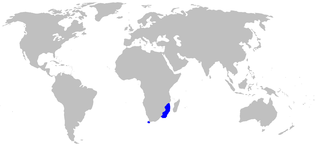
The white-spotted Izak or African spotted catshark is a catshark of the family Scyliorhinidae. It is found in the western Indian Ocean off the coasts of Natal, South Africa, southern Mozambique, Madagascar, Kenya, and Tanzania between latitudes 4° S and 37° S, at depths of between 220 and 440 m. It can grow up to 35 cm in length.

The narrowtail catshark is a catshark of the family Scyliorhinidae, found off the coasts of Honduras and Nicaragua, between latitudes 18° N and 10° N, at depths between 190 and 410 m. It can grow up to a length of 35 cm (14 in). The reproduction of this catshark is oviparous.
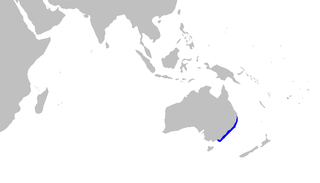
The Australian spotted catshark is a catshark of the family Scyliorhinidae, found only around Australia between 32 and 38°S, at depths between 10 and 180 m. It can grow up to 90 cm. Females of this species were observed as being reproductive year round. They are also confirmed as being a single oviparous species.

The pale spotted catshark, Asymbolus pallidus, is a cat shark of the family Scyliorhinidae found only off Queensland, at depths of between 225 and 400 m. Its length is up to 44 cm.
The dwarf catshark is a catshark of the family Scyliorhinidae, found only off the coast of Western Australia, at depths between 200 and 400 m. Its length is up to 44 cm.

The orange-spotted catshark or rusty catshark, is a species of catshark, and part of the family Scyliorhinidae. It is found only off the coast of Western Australia, at depths between 25 and 540 m. Its length is up to 39 cm (15 in).
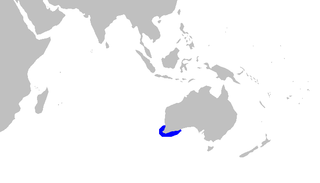
The variegated catshark is a cat shark of the family Scyliorhinidae, found off New South Wales and Western Australia at depths between 30 and 200 m. Its length is up to 41 cm. The reproduction of this catshark is oviparous.

The blackspotted catshark is a catshark of the family Scyliorhinidae. It is found in the waters off the coasts of Japan, Korea, China, and Taiwan between latitudes 39° N and 20° N, at the depths of between 80 and 100 m. It can grow up to 49 cm in length.

The speckled catshark is a catshark of the family Scyliorhinidae. It is found in the Gulf of Aden and off the coast of Somalia. It occurs at depths of between 37 and 250 m. Its length is up to 48 cm.
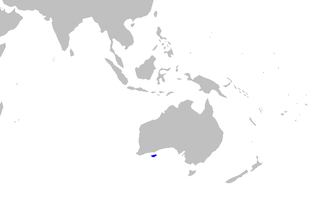
Asymbolus funebris, or blotched catshark, is a catshark of the family Scyliorhinidae, the only specimen, the holotype, being found off West Australia at 144 m. Its length is 44 cm and its reproduction is oviparous.

The Australian sawtail catshark is a common species of catshark, and part of the family Scyliorhinidae, endemic to southern Australian waters. It is found on or near the bottom of the outer continental shelf and upper continental slope, at depths of 85 to 823 m. This slim-bodied species is characterized by crests of enlarged dermal denticles along both the dorsal and ventral edges of its caudal fin and caudal peduncle, along with a color pattern of broad, dark saddles outlined in white. It can grow to 61 cm (24 in) in length. The Australian sawtail catshark feeds mainly on fishes, crustaceans, and cephalopods. Females are oviparous and lay eggs enclosed by capsules. This species is often caught incidentally by commercial bottom trawl fisheries, but is not significantly threatened by fishing activity. Thus, it has been assessed as of Least Concern by the International Union for Conservation of Nature (IUCN).

The northern sawtail catshark is a little-known species of catshark, and part of the family Scyliorhinidae, endemic to northeastern Australia. It is demersal in nature and inhabits the upper continental slope at a depth of 300–420 m (980–1,380 ft). A small, slender species growing no longer than 42 cm (17 in), the northern sawtail catshark is characterized by a series of dark, narrow saddles along its back and tail, and rows of prominently enlarged dermal denticles along the upper edge of its caudal fin and the underside of its caudal peduncle. The International Union for Conservation of Nature (IUCN) does not yet have enough information to assess its conservation status.
The roughskin catshark is a species of catshark in the family Scyliorhinidae found near Australia and New Zealand. Its natural habitat is the open seas. This species belongs to a genus of poorly known deep-water catsharks.
The saddled swellshark is a rare species of catshark, and part of the family Scyliorhinidae, endemic to Eastern Australia. This bottom-dwelling species is found on the outer continental shelf and upper continental slope at a depth of 115–605 m (377–1,985 ft). It is a robustly built shark with a short, broad, flattened head and a capacious mouth. Adults are patterned with saddles on a brownish or grayish background, which varies between tropical and temperate sharks; juveniles are light-colored with many spots. This shark reaches 74 cm (29 in) in length. Like other swellsharks, it can inflate itself as a defensive measure. Reproduction is oviparous.
The speckled swellshark is a little-known species of catshark, and part of the family Scyliorhinidae, endemic to the waters off northwestern Australia. It occurs on the outer continental shelf and upper continental slope, at a depth of 150–455 m (492–1,493 ft). This species grows to 69 cm (27 in) long and has a stocky body and a short, broad, flattened head. As its common name suggests, its color pattern consists of many dark spots and white-spotted dark saddles and blotches on a light gray background. The juveniles are yellow with dark spots and lines, and a distinctive eyespot-like mark behind each eye. Like other swellsharks, this species can inflate itself as a defensive measure.
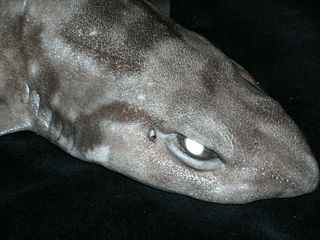
Scyliorhinus meadi, the blotched catshark, is a little-known species of catshark, and part of the family Scyliorhinidae, found in the western central Atlantic Ocean. It inhabits banks of deep-sea coral at depths of 329–548 m (1,079–1,798 ft), feeding on cephalopods, shrimp, and bony fishes. This species can be identified by its wide body and head, and the dark saddle-like markings on its back. It also has small spots that fluoresce yellow under a blue light. Adult blotched catsharks have not been observed; the largest immature specimen is 49 cm (19 in) long. Like other catsharks, it is believed to be oviparous. This species is not dangerous to humans and has no commercial significance.
Figaro is a genus of catshark, and part of the family Scyliorhinidae. Until 2008, Figaro was generally considered to be a subgenus of Galeus. The two known species are found off Australia, inhabiting deep, offshore waters on or near the bottom. Figaro contains small, slender, firm-bodied sharks that bear distinctive crests of enlarged, spiny dermal denticles along the dorsal and ventral edges of their short caudal fins. The caudal peduncle is relatively long, such as that the anal and caudal fins are some distance apart. In adult males, the inner margins of the pelvic fins are fused together to form a subtle "apron" over the claspers. F. boardmani is a predator of fishes, crustaceans, and cephalopods, and is oviparous; less is known about the F. striatus. Both are harmless and are of no economic importance.
















